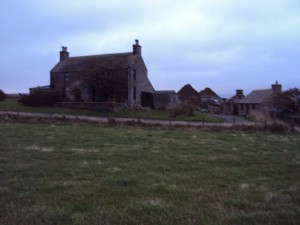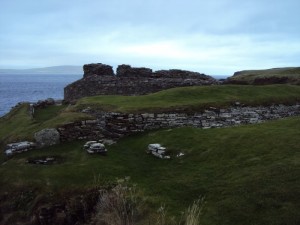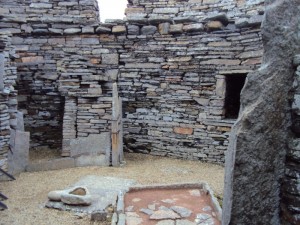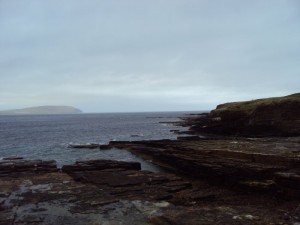So Magnus Erlendson, when he came up from the shore that Easter Monday, towards noon, to the stone in the centre of the island, saw against the sun eleven men and a boy and a man with an axe in his hand who was weeping.
― George Mackay Brown, Magnus
After that earl Magnus was borne to Hrossey, and buried at that Christchurch (in Birsay) which earl Thorfinn made them make. Straightway after that a heavenly light was often seen shining over his grave. Afterwards men began to call upon him often, if they were placed in danger, and their matter was granted at once as they prayed. In the same way a heavenly fragrance was often perceived at his grave, and sick men got back their health thence. Then next men made journeys thither both from the Orkneys and Shetland, who were in weak health, and watched at the tomb of earl Magnus the saint, and got healing for their ailments. But yet men did not dare to spread this abroad while earl Hacon lived. It is also so said, that those men who were most in the treachery against earl Magnus the saint, most of them died ill and harrowing deaths.
― The Orkneyinga Saga, 1230 AD
Flett was an Orkneyman. Eight hundred years ago there was a saint in Orkney; a political kind of saint, for he was Earl of Orkney before he became a nobleman in the hierarchy of Heaven. And both because of his sanctity and his temporal authority he had many enemies, so that one day he was attacked on a small island and brutally done to death by half a dozen ruffians in the pay of a rival to the earldom. One of the ruffians was a certain Thorkel Flett, who was rewarded for his share in such a notable murder by a grant of land. And that land had pastured enough mutton to feed his line for eight hundred summers, and grown enough corn to make malt for their eight hundred winters of drinking; for little work could be done in the dark stormy winters of the place. And the sea which bordered Thorkel Flett’s land gave generously too, of cod and haddock and lobsters and an occasional wreck; and in its turn took the lives of perhaps two in three of the men of the family. For one would farm and another would sail; one plant cabbages and feed his beasts and another go fishing in the Firth, or venture far to the north in whaling ships. Peter’s great-grandfather had commanded a whaler and had died within the Arctic Circle.
― Eric Linklater, White-Maa’s Saga
It was my intention, from the beginning, to do more than visit the famous sites on the Orkney Mainland. The other islands beckoned. The Isle of Rousay has a particular fascination for me. I first heard of it long ago, when read an article in Scientific American about the Neolithic passage graves of the island. This was a seminal study, which spearheaded a wave of new interpretations of neolithic structures in general. It pointed out that the passage graves on Rousay could be systematically related to specific patches of arable land. You could construct hypothetical tribal or clan territories, each overlooked by a tomb that both housed the dead and acted as a territorial marker. There were anthropological parallels to this in many parts of the world. This theoretical reconstruction was not, of course, provable, but its plausibility led to a broad range of inquiries into the relation of prehistoric structures and the landscapes they stand upon. These inquiries have transformed archaeology in the last generation.
Rousay is rich in archaeological sites. One short stretch of its western coast is remarkable in that it has, side by side, a large neolithic tomb, an Iron Age Pictish Broch, and the remains of a Viking settlement. It was this concentration of history that I wished to visit in the limited time I had remaining before I was forced to return to my mundane existence in Toronto.
Rousay is also peculiar in being the location of Orkney’s only “clearances” and its only crofters’ rebellion. During Viking rule, Orkney was under Odal law. Land was mostly farmed by its owners, rather than by tenants and subtenants. Orcadian historians tend to represent this period as one of rugged indepence and self-sufficiency, though this may be an idealized view. Scottish rule brought feudal serfdom. An aristocracy of landowners ― many of them absentees who never set foot on the land ― owned large tracts, and the work was done by tenant crofters and landless labourers, often subject to unlimited obligations to do unpaid non-agricultural work at beck and call. Crofters were assigned fragmentary patches of land, called “runrigs.” Under this system, the average Orcadian lived a life of poverty and exploitation. The absentee landlords syphoned away most of the islands’ surplus to finance lavish lifestyles in Scotland, or, later, England. The crofters were left with a bare subsistence. A great number were landless paupers, without even a tenancy, who hired themselves out whenever there was extra work to be done, and starved when there was none.
Things were even worse when landlords chose to “improve” their properties. Rousay experienced the only “clearance” in Orkney (the more famous Highland Clearances are familiar to every reader of Canadian schoolbooks). Tenants were “cleared”, i.e. forced off the land so that the Lairds could convert the runrig and common lands to sheep pasture. Rousay’s ruling Sinclairs had ambitions to improve production and “modernize” their holdings by abolishing the runrigs, consolidating them into larger tenancies. The surplus tenants were forced into the landless category. Many fled the islands. New crops and methods were introduced, and for awhile the lot of the remaining tenants seemed to improve, as productivity did increase. But as the land produced more, the rents tenants payed were raised correspondingly. The crofters were no better off. When the prices of produce collapsed in the middle of the 19th century, the “Little General”, as the Sinclair Laird of the time was known, sought to recoup his losses by raising the rents still more, driving the crofters to destitution.
Across Scotland, a Crofters’ Movement had come into being, in response to similar situations. On Rousay, a radically inclined Free Church minister and a self-educated crofter gave voice to the cause. Some minor violence occured. A visiting commission heard testimony, which reached sympathetic ears in the reforming administration of the era, to the consternation of the Little General. All of this is chronicled in a fine book by William P.L. Thomson: The Little General and the Rousay Crofters. Anyone who is under the impression that feudal tenure was a benign system of reciprocal obligations ― a view that has been gaining in popularity in recent years ― is well advised to read this book. It will throw some cold water on that comforting delusion.
Rousay must be reached by sea. The ferry does not leave from Kirkwall, as those for most of the other islands do. Instead, a small ferry serving the islands of Rousay, Egilsay, and Wyre leaves from the microscopic village of Tingwall. My time constraints prohibited walking or hitching to Tingwall, so I took a local bus. “Tingwall” is one of the more obviously Norse place names of Orkney, as it is transparently cognate with Old Norse thingvellir, meaning “assembly field.” In this case, a very particular assembly occured here, and it was part of the most dramatic incident recounted in the Orkneyinga Saga. In the year 1174, the vikings Magnus Erlendsson and his cousin Haakon Paulsson had been jointly ruling as Earls of Orkney for nine years. But they had grown to be great rivals. A faction was particularly upset by Magnus’s religious piety, which had led him to skimp on the expected degree of Viking skull-splitting. At a thing (conference, assembly, parlay) held at this place, peace between them was negotiated. Haakon and Magnus agreed to meet again on the nearby island of Egilsay, each bringing only two ships. But Haakon arrived with eight ships, and treacherously arranged for Magnus to be murdered as he prayed in Egilsay’s church. Subsequently, Magnus was seen as a Christian martyr, and made a saint. The cathedral in Kirkness is named for him.
When I arrived, it was overcast and gray, and growing cold. The settlement was no more than a dozen widely scattered houses. The house closest to the ferry landing was next to the collapsed ruins of an older house. The sky roiled with menacing clouds, and the wind picked up. The voyage to Rousay took place in this worsening weather. While the crossing of the Pentland Firth in the giant Hamnavoe was as smooth as a ball rolling across a billiard table, this crossing was somewhat different. The ferry was tiny. The wind howled. The sea was black ― or rather, it was the colour of photocopier toner powder. The sea was choppy. The boat bobbed and swayed like a cork in a washing machine. But the handful of passengers seemed unperturbed. I was a nervous landlubber, but I concluded that, if they weren’t concerned about it, then I needn’t be.
But the sea has always intimidated me. I could not look into that dark, churning water without imagining its paralysing cold and the terror it would hold for me if I was cast into it. The howling wind, and the relentless grayness of the sky, the screaming seabirds, and the racing whitecaps all re-inforced the effect. I remembered the maritime charts I had looked at, which marked the seas just to west of our position with phrases like “waters to be avoided” and “dangerous waters.” Much of the Spanish Armada had perished near here, when a powerful storm smashed them to flinders on Orkney’s reefs. The few survivors who made it to land found only sharp rocks and high cliffs to seal their doom. Such were my childish thoughts. Doubtless, the sea-loving Orcadians would think me a pathetic idiot, frightened by perfectly normal and harmless weather.
There is no real village on Rousay. Houses and other buildings are scattered along a ring road, circling the island. In most places, cliffs or a steep rise in land keep the road well away from the shore. The Millners of Rousay (a family famed in archaeology), kindly drove me to the place I wanted to go. On the way, they pointed out the house of the “Little General” and another built by earlier Lairds. They told me which part of the island had been affected by the clearances. With gratitude, I waved them goodbye, as they left me to examine the ancient sites. It was a steep descent from the road to the sites, which hugged the shore.
It was there that I experienced an epiphany. Now, I’m generally not too keen on epiphanies. Like evangelical conversions, they tend to occur with suspicious convenience and to result in no perceptible change. But I’ll grant an exeption in this case. I was alone, of course. There were no tourists on Rousay at this time of year. The three sites, closely linked in space, but not in time, were every bit as interesting as I had hoped. At first, I wandered about, snapping photos, especially of the Pictish broch, which is spectacular. These structures are characterized by double walls, linked together by stone butresses. This technique allowed the Picts to build tall, conical towers. Staircases wound around them, giving access to multiple wooden interior platforms. The exact purpose of the brochs is not certain, but they look defensive, something like castle-keeps or watchtowers. They were large enough to contain substantial living quarters. They tend to suggest some kind of defense against sea raiders. This particular one overlooks the entrance to the sea passage between Rousay and the Mainland, and there’s another broch in a similarly strategic position on the opposite shore.
The Viking settlement was far better preserved than I expected, with large portions of the stone houses still standing.
Waves crashed onto the flagstone shore, within yards of me. Sheep confronted me, bleated, and fled. The ruins, built thousands of years apart from each other, nevertheless seemed to conspire to be a single thing, a kind of temple to the depth of time. The passage grave, long ago given a concrete protective bunker, seemed like it would expel some Lovecraftian Yog Sothoth at any moment.
After some time poking around these ruins, a strange mood descended upon me.
I had travelled a great distance, to a remote and obscure destination, in part to satisfy my historical curiosity, but chiefly to remove myself from the routine and ordinariness that my life was beginning to fall into. My life has seldom been comfortable, or ordinary, and it’s understandible that, after years of wandering and uncertainty, I should be turning to a more comfortable and predictable lifestyle. But I can’t help but feel ambivalent about it, no matter how practical it might be. In addition, I still bore the scars of some bitter experiences. A few years ago, some betrayals and humiliations had driven me to great despair, and wounded me deeply. I usually deal with such things by burying myself in work. But I couldn’t say that there had ever been any clear resolution to those wounds, or any recovery.
Now I stood on a cliff, swept by a cold wind, looking over a dark ocean in the direction of my own, distant homeland. Centuries ago, men with nothing more than a flimsy wooden ship had crossed that immense distance. They had done it with no knowledge of what awaited them, in a world that held supernatural terrors that I can’t conceive of. Behind me stood an assortment of stone ruins that testified to fifty generations of people struggling to survive. The sky above me was huge. There are times when you feel very, very small.
The land rose in a great diagonal swoop from the crashing waves up to the high hills. Sheep milled about in the close and long distances. It was a dark tableau. I was cold and wet, and the taste of old bitterness swirled in me like the gulls that swooped along the cliffs. Yet this was also a moment of calm and beauty.
The climb up to the road was steep and tiring. I anticipated a long walk to get to the ferry dock. My mind was scattered, no longer capable of truning my experiences and feelings into words. My feelings were, at any rate, inchoate. Did I feel comfort, relief, serenity, rectification, resolution? No, none of those things. No solution had been found. Nothing had come out even. No question had been answered. No conclusion had been reached.
As epiphanies go, this was not one that could be milked for a novel, or peddled as wisdom.
An islander, a young woman, turned up when I reached the road. She gave me a ride to the ferry. She did not offer, and I did not ask, her name.




0 Comments.